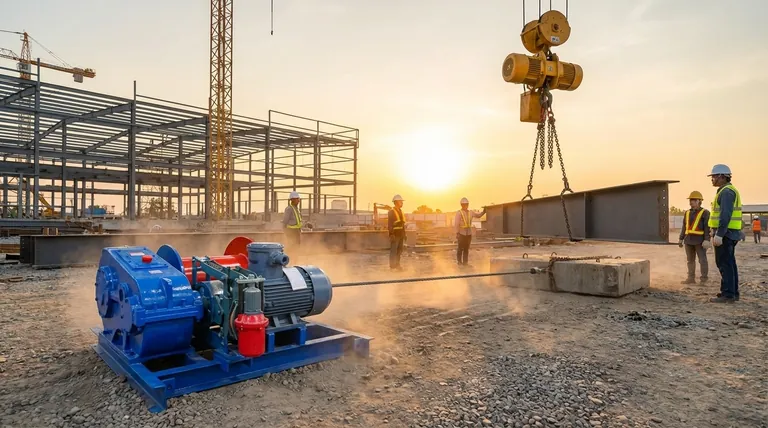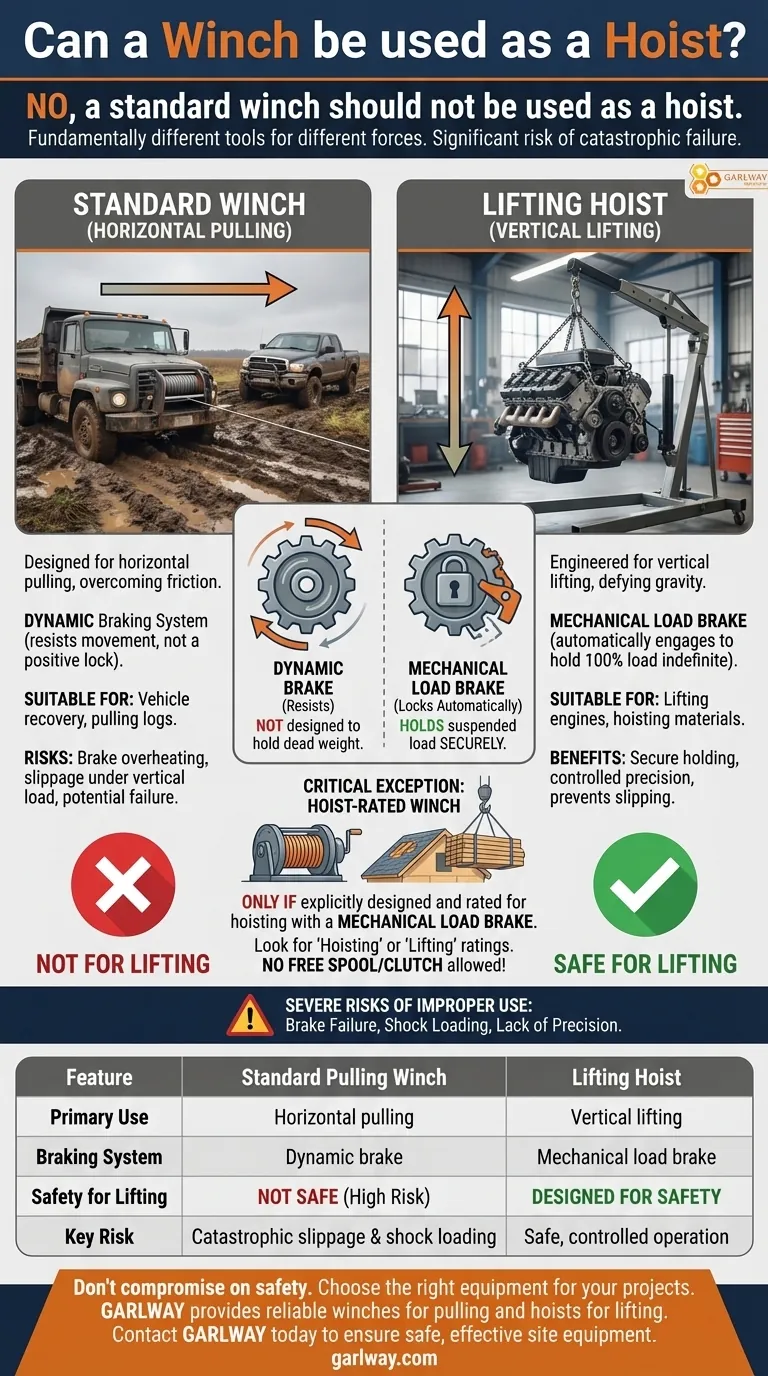No, a standard winch should not be used as a hoist. While they appear similar, they are fundamentally different tools designed for different forces and safety requirements. Using a pulling winch for vertical lifting introduces a significant risk of catastrophic failure, as it lacks the essential braking systems required to safely hold a suspended load.
The core issue is not the name "winch" vs. "hoist," but the mechanism's design purpose: pulling vs. lifting. A standard winch is built for horizontal pulling, overcoming friction. A hoist is built for vertical lifting, defying gravity with a brake designed to hold a suspended load without slipping.

The Critical Difference: Braking Systems
The distinction between a pulling winch and a lifting hoist comes down to how they manage the load. This difference is most apparent in their braking systems.
How a Standard Winch Works
A standard winch, like one on the front of a truck, is designed to pull a load horizontally.
Its braking system is typically dynamic, meaning it relies on resistance within the motor and gear train to prevent the drum from unwinding. This is sufficient for managing a rolling or sliding load, but it is not a positive locking brake.
How a Hoist Works
A hoist is engineered specifically to lift a load vertically and hold it securely in place.
It incorporates a mechanical load brake, such as a Weston-style brake. This type of brake automatically engages the instant you stop lifting, physically locking the load in place. It is designed to hold 100% of the rated load indefinitely, even if power is lost.
Can a Winch Ever Be Used for Lifting?
Yes, but only if it is a specific type of winch explicitly designed and rated for the task. These are often called "hoisting winches" or "lifting winches."
What to Look For in a Hoist-Rated Winch
To be considered safe for vertical lifting, a winch must have a mechanical load brake. It will be clearly advertised and rated by the manufacturer for "hoisting" or "lifting" applications, not just "pulling."
Red Flags to Avoid
Never use a winch for vertical lifting if it has a free spool or clutch feature. This mechanism, designed to let you quickly pull out the rope by hand for horizontal recovery, is an extreme liability in a lifting scenario. Accidentally engaging it would cause the suspended load to drop instantly.
Understanding the Severe Risks
Using the wrong tool for the job is not a matter of minor trade-offs; it's a serious safety hazard.
The Inevitability of Brake Failure
A standard winch's dynamic brake is not designed to hold a dead-weight vertical load. Under this constant gravitational force, the brake can overheat, slip, and eventually fail completely.
The Danger of Shock Loading
Even a small amount of slippage can be disastrous. When a load drops even a few inches and is caught again, it creates a "shock load"—an instantaneous force that can be many times the actual weight of the object. This can easily snap the rope or shatter the winch's internal gears.
The Lack of Precision and Control
Hoists are built for slow, precise, and controlled movement. Winches are often geared for faster line speed, making it difficult and unsafe to accurately position a heavy, suspended object.
How to Choose the Right Tool for Your Goal
Your application dictates the correct equipment. There is no ambiguity here.
- If your primary focus is recovering a vehicle or pulling a log across the ground: A standard pulling winch is the correct and safe tool for the job.
- If your primary focus is vertically lifting an engine from a car or hoisting materials in a workshop: You must use a device with a mechanical load brake, such as a chain hoist, an electric hoist, or a winch specifically rated for hoisting.
- If your primary focus is lifting construction materials over a long vertical distance (e.g., to a roof): A specialized "hoisting winch" is often the best choice due to the long reach of its wire rope system.
Always prioritize the tool's safety features and manufacturer's rating over convenience.
Summary Table:
| Feature | Standard Pulling Winch | Lifting Hoist |
|---|---|---|
| Primary Use | Horizontal pulling (e.g., vehicle recovery) | Vertical lifting (e.g., lifting engines) |
| Braking System | Dynamic brake (resists motor/gear movement) | Mechanical load brake (locks load automatically) |
| Safety for Lifting | Not Safe - High risk of brake failure | Designed for Safety - Holds load securely |
| Key Risk | Catastrophic slippage and shock loading | Safe, controlled operation when used correctly |
Don't compromise on safety and efficiency. Choosing the right equipment is critical for your projects. GARLWAY specializes in robust construction machinery, offering reliable winches for pulling and hoists for lifting. Whether you're a construction company or a contractor, we provide the right tools for the job.
Contact GARLWAY today to discuss your specific needs and ensure you have the safest, most effective equipment on your site.
Visual Guide

Related Products
- Electric and Hydraulic Winch for Heavy Duty Applications
- Warn Winch Windlass Boat Trailer Winch
- Electric 120V Boat Winch by Badlands
- Best 18000 Pound Drum Anchor Trailer Winch
- 12000 lb Heavy Duty Electric Boat Winch
People Also Ask
- Do electric winches have brakes? Essential Safety for Your Heavy-Duty Pulling
- What is the difference between electric winch and electric hoist? Essential Safety & Application Guide
- How to maintain an electric winch? Ensure Peak Performance & Reliability for Your Projects
- How do I choose an electric winch? A guide to safe and effective pulling power.
- How to power an electric winch on a trailer? Choose the Best Method for Your Setup



















